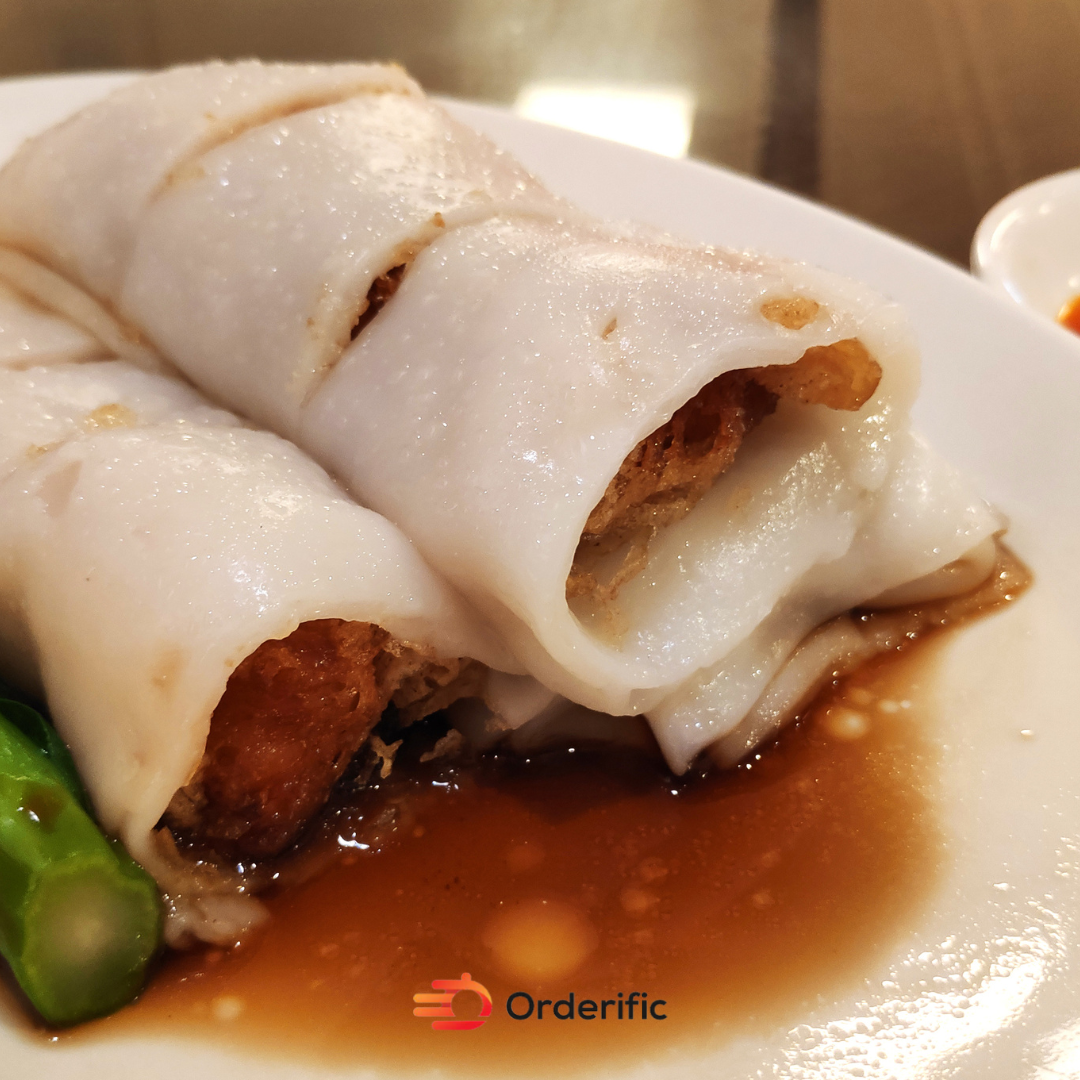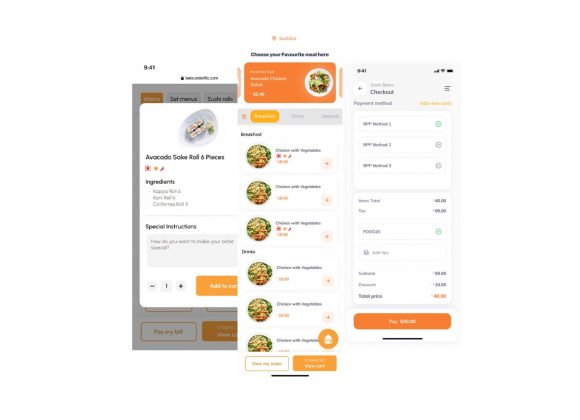Are you looking for a light and delicious snack to enjoy any time of day? Shrimp rice noodle rolls, also known as Cheung fun in Cantonese cuisine, are ideal. Soft and chewy crispy on the outside, these savory treats make a wonderful appetizer.
Made from steamed rice flour sheets stuffed with juicy shrimp, they cook quickly and provide plenty of flavor. This recipe will show you how to assemble them step-by-step easy enough for even novice cooks to execute flawlessly!
What Are Rice Noodle Rolls (Cheung Fun)?
Rice noodle rolls, also known as “Cheung fun” in Cantonese cuisine, are a popular and delectable dish commonly found in Chinese dim sum restaurants and street food stalls. These delicate and translucent rolls are made from rice flour mixed with water and perfectly steamed. The resulting thin, smooth sheets of rice noodles resemble silky blankets.
With their delicate appearance and delicious fillings, rice noodle rolls have become a beloved Chinese cuisine staple, cherished by locals and food enthusiasts worldwide.
How to Make the Ideal Shrimp Rice Noodle Roll Batter
Preparing the batter for rice noodle rolls is a straightforward process that calls for a handful of essential ingredients. Below is a recipe to guide you in creating the perfect batter:
Ingredients:
– 1 cup rice flour
– 2 tablespoons cornstarch
– 1 tablespoon tapioca flour or tapioca starch (optional for added chewiness)
– 1 1/2 cups water
– 1/2 teaspoon salt
– 1 tablespoon vegetable oil
Instructions:
- In a mixing bowl, combine the rice flour, cornstarch, tapioca flour (if using), and salt. Mix the dry ingredients together thoroughly.
- While stirring continuously, gradually incorporate the water into the dry mixture, ensuring a smooth batter without any lumps.
- Incorporate the vegetable oil into the batter and thoroughly combine. Adding oil will prevent the rice noodle rolls from adhering to the steamer, ensuring a smooth and seamless cooking process.
- Allow batter to rest for approximately 20-30 minutes. During this period of rest, the flour fully absorbs moisture, creating rice noodle rolls that are not only smoother but also more elastic in texture.
- After allowing the batter to rest, please give it a thorough stir before usage. The ideal consistency should be thin and smooth, akin to that of heavy cream. If the batter appears too thick, incorporate a small amount of water to attain the desired consistency.
Now, you are prepared to create your delicious rice noodle rolls.Start by pouring a thin layer of the batter onto a greased and heated steamer tray. Steam it until it sets, typically around 2-3 minutes and your steamed rice rolls or rice noodle rolls are ready.
How to Make Rice Noodle Roll Sauce
The preparation of the sauce for rice noodle rolls is equally vital to the process of making the rolls themselves. It is imperative to prioritize and pay attention to both aspects to ensure a delightful culinary experience. There are various versions of the sauce, but here is a straightforward recipe for a timeless savory sauce that beautifully complements the delicate flavors of rice noodle rolls –
Ingredients:
– 3 tablespoons soy sauce
– 2 tablespoons hoisin sauce
– 1 tablespoon oyster sauce
– 1 tablespoon sesame oil
– Sugar (1 tablespoon / adjust to taste)
– 1/2 cup water
– 1 clove garlic, minced (optional)
– 1/2 teaspoon white sesame seed (optional)
Instructions:
- Let’s bring together a tantalizing medley of flavors in a small saucepan! Combine the soy sauce, hoisin sauce, oyster sauce, sesame oil, sugar, water, and minced garlic (if using). Please give it a good mix, ensuring all the ingredients dance together harmoniously.
- Gradually heat the saucepan over low to medium heat, allowing the mixture to gently simmer. Stir occasionally to ensure the flavors meld harmoniously.
- You have the perfect opportunity to introduce some fiery elements to give the sauce an extra kick of spiciness. Consider adding a tantalizing dose of chili oil or zesty chili sauce at this very moment. Get ready to ignite your taste buds!
- Allow the sauce to simmer for approximately 2-3 minutes, enticing it to thicken ever so slightly. Should the sauce dare to become overly thick, fear not! Introduce a touch of water to achieve the desired consistency.
- Indulge in a tantalizing taste of the sauce and perfect its sweetness or saltiness by adding a touch of extra sugar or soy sauce, as needed.
- Once the sauce is prepared, give it a moment to cool off the heat before serving. This simple step will elevate the dish, preserving its true essence while enhancing its overall quality.
Consider delicately sprinkling a handful of white sesame seeds on top for an enhanced texture and presentation. The sauce for your rice noodle rolls is now prepared and ready to be served alongside the freshly made rolls. Enjoy the perfect pairing of flavors!
How to Make Rice Noodle Rolls (Cheung Fun) at Home
Impress your family and friends with your cooking skills by making homemade rice noodle rolls (Cheung Fun)! You can follow the steps mentioned earlier in this blog post to make the rice noodle rolls and the accompanying sauce.
Once you have your steamed rice roll (rice noodle rolls) and sauce ready, it’s time to add the filling of your choice. Maybe some savory pork, tender shrimp or dried shrimp, or crispy vegetables? No matter your preference, add your desired ingredients to the rice noodle rolls, generously drizzle with the delectable sauce, and serve!
Different Types of Fillings for Your Cheung Fun
If you’re a fan of Cheung fun, the delicious and delicate Cantonese rice rolls, you probably know that the filling options are countless. Whether you like your rolls savory or sweet, vegetarian or stuffed with meat, there’s a filling out there that will satisfy your cravings.
Some popular savory fillings include –
- Shrimp
- Char Siu (barbecued pork)
- Mushrooms
While sweet options range from red bean paste to coconut cream.
Cheung fun can also be filled with unexpected ingredients like spicy minced beef or even Chinese donut sticks. With so many options, you can always enjoy this staple Cantonese dish.
Best Practices for Rolling and Cutting the Rice Noodles
Rolling and cutting rice noodles can be a bit challenging, but with the right techniques, you can achieve smooth and perfect rice noodle rolls. Here are some best practices for rolling and cutting rice roll noodles:
- Steaming Time and Thickness: Ensure that you steam the rice noodle batter for the right amount of time and to the proper thickness. Excessive steaming can cause the noodle sheet to dry out excessively, making it difficult to roll. Conversely, insufficient steaming can lead to a sticky and unmanageable sheet.
- Greasing the Tray: To avoid the rice noodle sheet from sticking to the steamer tray, applying a thin layer of oil on the tray before pouring the batter is crucial. This simple step will ensure a smooth and hassle-free cooking experience.
- Rolling with Care: When rolling the rice noodle sheet, be gentle and avoid using too much pressure. The delicate nature of the noodle sheet can make it susceptible to tearing. Use the cloth or rolling mat to guide the rolling process, making achieving a tight and even roll easier.
- Filling Placement: When adding the filling, distribute it evenly along the width of the rice noodle sheet, leaving some space on the sides for sealing the edges.
- Sealing the Edges: To seal the edges of the rice noodle roll, use a little water on your fingers to moisten the edges of the noodle sheet before rolling. This will help the edges stick together and prevent the roll from unraveling.
- Cutting the Rolls: When cutting the rice noodle rolls, use a sharp knife dipped in water to prevent sticking. Slice the rolls gently to maintain their shape and appearance.
Mastering the art of rolling and cutting requires practice and patience. These are the essential ingredients for achieving excellence in this culinary craft. You’ll become more skilled with time, and your homemade rice noodle rolls will turn out beautifully!
Conclusion
Cheung Fun are a classic Chinese dish that is beloved by many. The best way to make your own homemade Cheung Fun is to start with the ideal batter, then choose your favorite fillings, rolling and cutting technique.
With a variety of ingredients and techniques available, you can tailor-make your Cheung Fun to fit your creative tastes. Although time-consuming and delicate, homemade rice noodle rolls are worth the effort – so why not give it a try?
If you’re still unsure where to start, why not read our other Orderific blogs for more tips and tricks on creating delicious food easily! So gather all of your ingredients, take out those chopping boards, and get rolling – it’s time to create some homemade Cheung Fun!
FAQs
Q. How are rice noodle rolls made, and what is the traditional method for preparing this popular dish?
Ans. Rice noodle rolls are made by steaming a rice batter into thin sheets, which are then rolled up with fillings like shrimp or char siu; traditionally, they are prepared in bamboo steamers.
Q. Can you provide insights into the different variations or fillings commonly used in rice noodle rolls?
Ans. Common variations include fillings like beef, pork, vegetables, and even sweet options with custard or red bean paste.
Q. Are there any specific sauces or condiments that are traditionally served with rice noodle rolls to enhance their flavor?
Ans. Traditional sauces served are usually soy sauce-based, like hoisin sauce or sweet soy sauce.
Q. Can you recommend some tips or techniques for achieving the perfect texture and consistency of rice noodle rolls during cooking?
Ans. To achieve the perfect texture and consistency, ensure the steaming process is timed accurately, the rice batter is of the right thickness, and the steamer surface is lightly greased.













